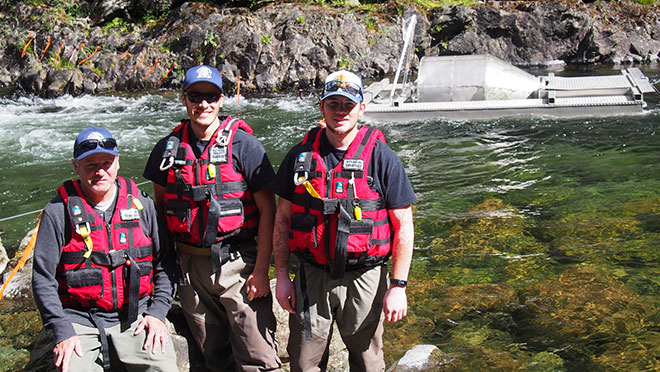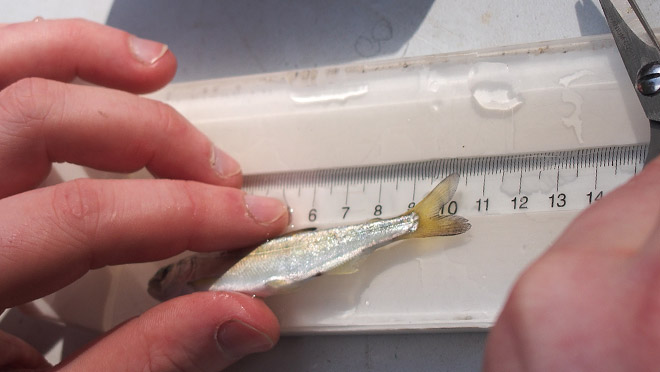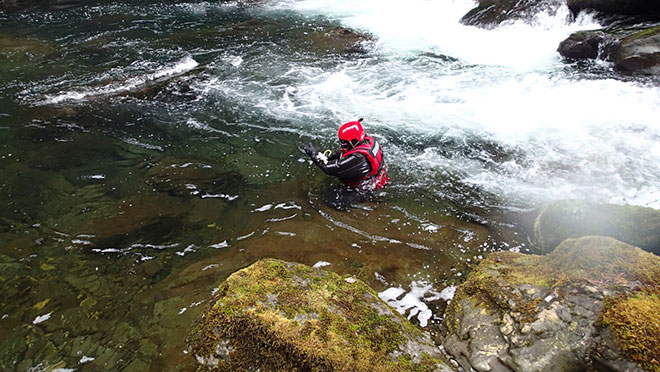First Nations trio trap and study salmon for BC Hydro

Projects at Campbell River provide job opportunities for locals
Former commercial seine boat fisher Mike Dick is still in the salmon game, but the fish he's scooping out of a trap on the Campbell River are so small that he could fit one in the palm of his hand.
Budding marine biologist Zach Everson is deft enough with scissors that he can cut off a sample of salmon for DNA testing and be assured that the fish, released back into the river a few minutes later, will survive.
And Zach's younger brother Jordan, pleased to no longer be working as an overnight security guard, can also tell you that a bit of Alka Seltzer sprinkled in water reduces the oxygen content just enough to sedate a salmon so that it can be measured, weighed and DNA tested without flopping off the table and onto the rocky beach below.
"This is way better than fishing," says Mike."Fishing was going downhill and I was just going through the motions. With this, there's such a variety of work I have to do. Tomorrow, I have to get a boat with twin 150 (horsepower engines) and go up to Upper Campbell Lake to do other sampling."
By the fall, all three will be in snorkel gear swimming alongside the salmon and counting them, sometimes by flashlight in dark waters after dusk. It's all part of the fish monitoring work they do for BC Hydro through a contract with Laich-Kwil-Tach Environmental Assessments Limited Partnership (LKT) to monitor fish populations and water flows in the Campbell River system.
The We Wai Kai (Cape Mudge) and Wei Wai Kum (Campbell River) First Nations have formed LKT, and they have become a regular environmental work partner as BC Hydro studies how operational and flow changes – the result of the latest Campbell River Water Use Plan – may be benefitting fish and recreation users of the river system. LKT has a direct working relationship with A'Tlegay Fisheries Society, which is made up of technical staff from five local First Nations.
Mike comes from the Kwiakah First Nation, while Zach – who's studying marine biology at Nanaimo's Vancouver Island University – and brother Jordan are from the K'ómoks First Nation.
According to Jeff Walker, BC Hydro's environmental risk management lead for water use planning studies in the Coastal region, there are 13 monitoring projects taking place over 10 years in Campbell River, with eight of them already underway and being conducted by LKT. Several physical works projects will also be completed over 10 years.
The LKT crew are a small part of an economic rebirth in an area that had been hard hit by mill and mining closures in the early 2000s, but which is bouncing back (YouTube).
"There are 360 people working on the John Hart Generating Station Replacement project right now in Campbell River," says Stephen Watson, BC Hydro's stakeholder engagement advisor for the area. "And that's just the John Hart project. We're also spending about $30 million with crews currently upgrading the Campbell River substation to allow the community to continue to grow. And there are major projects following, including seismic upgrades to the John Hart Dam and the Strathcona Dam.
"With these projects happening and proposed, we're in Campbell River for 20 years-plus with major capital projects, with really good opportunities for job seekers and subcontractors."

New water bypass part of nearly $1.1 billion in projects at John Hart
A tunnel through rock will replace the aging, above-ground wooden penstocks that carry water from the dam at John Hart reservoir to the powerhouse about 1.8 km downstream. And that powerhouse itself is being rebuilt to an underground location, replacing the old one that has held a very prominent position on the Campbell River since it went into operation way back in 1947.
At nearly $1.1 billion, the various John Hart project upgrades are not only about seismic and efficiency upgrades. They'll also amount to improvements to water flow.
If there's an unplanned shutdown to some of the six turbines in the current powerhouse, it can take up to an hour to restore the flow of water in the Campbell River by spilling it through the dam much further upstream. As 95% of the river's water flows through the generating station, that can temporarily lower water levels and potentially endanger fish populations. But a water bypass is being built at the new underground station, where water destined for any of the three new turbines can, with the automated switch of valves, be redirected downstream immediately after a turbine is shut down.
"If one turbine goes offline for any reason, we'll quickly redirect the flow so that there's seamless continuity of river flow downstream," says Watson. "We're going to go from a flow recovery of about an hour, where you can potentially strand downstream fish, or expose fish habitat, to a seamless flow. It's a huge improvement for fish."

When fall arrives, the LKT crew will jump in the river
The section of river Mike and the Everson brothers monitor fish populations on represents the 5% of the water from John Hart Reservoir that's not used for power generation. It's a stunningly beautiful river section upstream from the old power station to spectacular Elk Falls, and the canyon sides are steep. The LKT crew – which regularly consults with BC Hydro about safety issues – relies on ropes to help them get down to the river safely.
BC Hydro has relied on a carefully crafted annual flow regime, allowing the right amount of water through the John Hart facilities in an attempt to mimic a river's natural, seasonal flow fluctuations and to help fish populations flourish. It's the task of the LKT crew to monitor those flows by regularly sampling fish from a trap in the river, and in the fall, by swimming alongside them.
"I like snorkelling this river," says Mike. "We start by walking up the river – it takes us about an hour and a half – and then we jump in there and snorkel down, counting fish. We snorkel it about 20 to 30 times in the fall."
Campbell River is so famous for its sportfishing that it's marketed as the Salmon Capital of the World, and the river itself has become famous for snorkelling with salmon outings with Destiny River Adventures.
Asked for a few local tips on fishing for salmon in the ocean around the city, the Everson boys don't hesitate.
"The Hump," says Jordan, referring to the salmon fishing hot spot off Cape Mudge.
"Or Green Can out of the south end of Quadra Island," he adds.
Zach chuckles, then wraps it up.
"A trick is to just follow a Painter's Lodge boat, because they're going to go to all the best spots," he says, referring to the famous charter fishing company.
Related:
John Hart Generating Station Replacement project helps Campbell River bounce back (YouTube)
Also in September's Connected eNewsletter:
- Words & video: Bend-and-break wood pole test helps save millions
- 9 smartphone apps to help you stay organized this fall
- 'Goose guards' atop power poles help keep osprey away
- How far will that electric car go? More models, charging stations change the game
- John Hart, Site C project benefits go beyond clean, reliable power